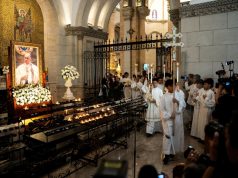
MALABON City— Below is the full text of Cardinal Pablo Virgilio David’s homily, delivered during Easter Sunday Mass at the Diocesan Shrine and Parish of the Immaculate Conception in Malabon City on April 20, 2025:
If there’s anything uniquely Filipino about how we celebrate Easter, it’s our early morning ritual called Salubong.
I’ve tried to find the right English equivalent for Salubong, but I’ve never really found one that captures its full meaning. Could it be “to meet”? Possibly—but not everyone we meet is someone we go out of our way to welcome. How about “to look for someone”? That works too—because yes, in order to salubong someone, you usually go out searching for them. But not everyone who searches actually finds what—or whom—they’re looking for. Could it be “to welcome”? That gets close, but even welcoming can happen passively—you can just wait at home and open the door. The closest might be a combination of many words: to meet, to seek, and to welcome with open arms and longing.
In the Gospel we heard, Mary Magdalene, Peter, and John all went out, they ran, they searched—but still, they did not find. In fact, in John’s account, it wasn’t Mary who met the Risen Jesus—it was Jesus who met her. He surprised her—caught her off guard. And she only recognized Him when He called her by name: “Mary.”
Sometimes we miss those we’re trying to meet—maybe we go to the wrong place. Like someone who arrives at the wrong airport. Or maybe the person you were waiting for had already arrived—but they had to take a taxi home because you weren’t there. Or maybe there were just too many people at the arrival gate, and your paths never crossed.
That’s why some people who wait for loved ones at airports carry signs—so they can be more easily recognized.
Do you remember the song “Tie a Yellow Ribbon”? It tells the story of a man who had been in prison and was finally coming home. He wrote to his wife beforehand, asking if she would still welcome him. Because he wasn’t sure. So he said, “You don’t even have to come meet me. Just tie a yellow ribbon around the old oak tree near our house. If I don’t see it, I’ll stay on the bus and just move on.”
And so, as the bus approached his home, he was too scared to look. He asked the driver, “Please, can you look for me? I’m not sure I can bear it if I don’t see that ribbon.”
But the surprise?
The whole bus erupted in cheers.
Not just one ribbon, but a hundred yellow ribbons were tied around every tree along the road. The welcome was overwhelming. That’s why the song became so symbolic in the Philippines back in 1986—during a time when we, as a people, were longing to come home to truth, to freedom, to hope.
For the disciples who had failed Jesus—especially those who had abandoned Him at the cross—the idea of a joyful Salubong must have been difficult. They had all gone into hiding out of fear. But the message of Easter is this:
If you truly wish to meet the Risen Lord, you have to step out.
You have to come out of hiding.
You have to walk into the light.
Mary Magdalene stepped out, yes—but even then, she didn’t recognize Jesus at first. Maybe because of her grief, her mourning. That’s why, in our Salubong, we cover the image of Our Lady with a black veil—she is the Mater Dolorosa, the grieving Mother. That veil represents not only her mourning, but also the darkness that clouds our vision when our hearts are heavy and broken.
When our hearts are covered in darkness, we cannot see the light—even if it’s already standing right in front of us.
It’s like what’s happening in our country. How can we recognize leaders who genuinely care for our people, when we allow our eyes to be blinded by ayuda? When we mistake propaganda and viral posts on social media for truth? When our hearts are full of resentment and anger, how can we see hope? When we allow bitterness to fester, how can light break in?
Jesus once said, “If your eye is bad, your whole body is in darkness. And if the light in you is actually darkness, how deep that darkness must be!”
Sometimes, we need help finding our way. We need to be guided by signs—markers that lead us back to truth. That’s why it’s important for the younger generation to listen to the wisdom of those who’ve gone before them. If not, they might get lost—and miss out on the future waiting to meet them.
Those who don’t go out to meet, receive no welcome gift.
We’ve spent forty days preparing for this Salubong—this joyful Easter encounter. But the disciples waited fifty more days before they received the greatest Pasalubong—on Pentecost.
Jesus told them: “You will receive power when the Holy Spirit comes upon you, and you will be my witnesses—to the ends of the earth.”
That’s why we go out to meet Him—because we are also waiting for the gift of the Resurrection:
the Holy Spirit,
the One who gives hope to the hopeless,
who binds us together in love,
who remains with us even when we can no longer see Him.
He is the happy ending to our stories—no matter how dark, painful, or tragic.
I once asked a young person, “If the Tagalog of Merry Christmas is ‘Maligayang Pasko,’ what’s the Tagalog of Happy Easter?”
He said, “Happy Easter din po.”
The older ones might say, “Maligayang Paskong Pagkabuhay.”
But I have a suggestion:
Let’s start a new tradition.
Let’s create a new way of greeting one another a Happy Easter in Tagalog. Let’s say:
“Maligayang Pagsalubong!”









